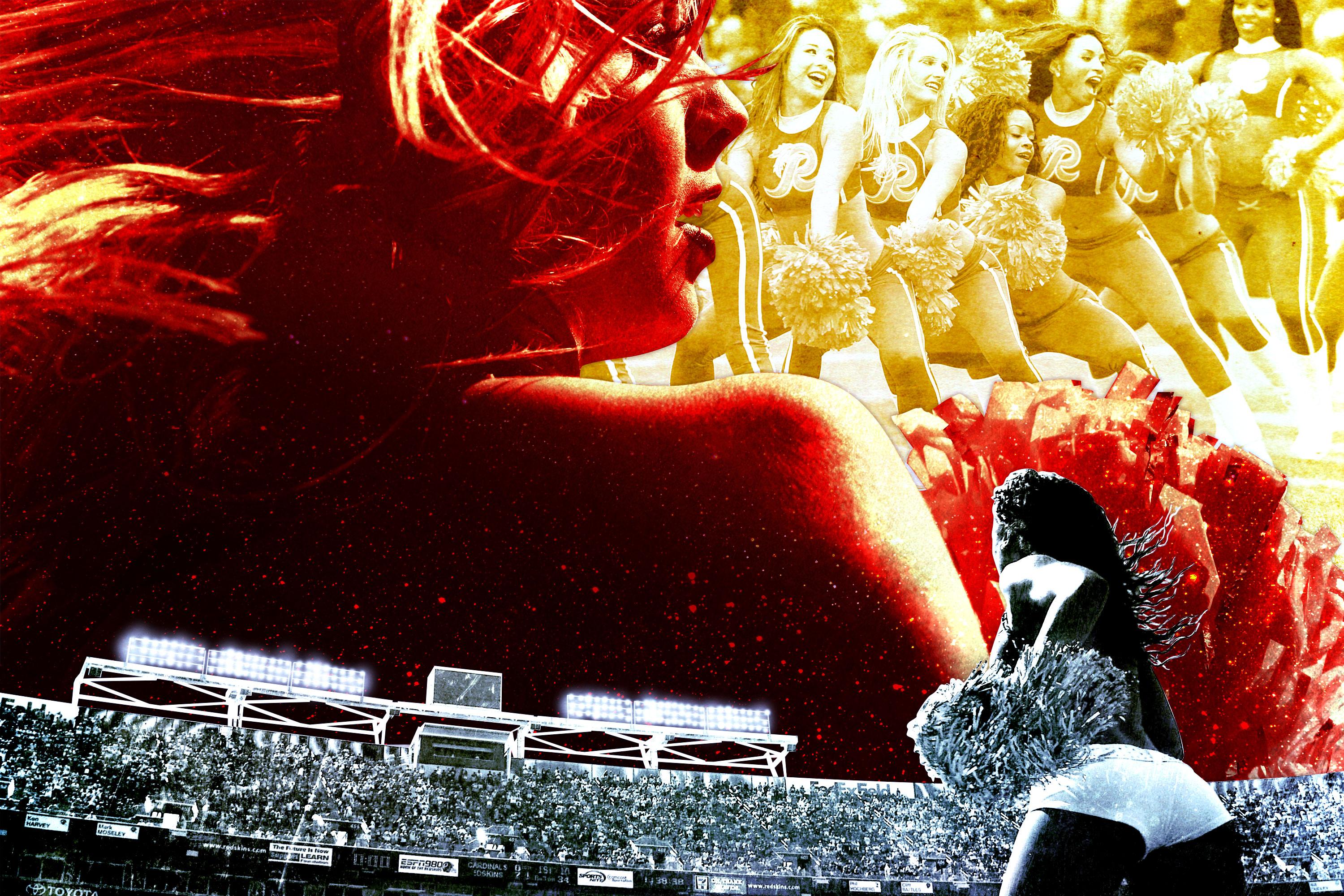
Last week, the Redskins announced that changes are coming to the team’s in-house cheerleading squad. Beginning this season, cheerleaders on game days will be dressed in a more “demure” fashion after team officials selected the five “most conservative” of their 22 existing uniforms for 2018 use. Perhaps men might join the performances, as they have this fall for the first time with the Rams and Saints squads. Suite holders will no longer be invited to attend the squad’s annual swimsuit calendar photo shoot.
The changes in Washington aren’t out of the blue—they arrive nearly five months after The New York Times published a damning report that detailed an array of sketchy practices enforced by the team, including topless photo shoots with male suite holders looking on and instances where cheerleaders were told to accompany those men to nightclubs. And so this is as good a moment as any to take a step back and ask: Why—why—do professional football games also feature women dancing in their underwear?
This is the modern NFL cheerleader experience. Troupes of young women in team uniforms that cover exceedingly little—a sequin bra, maybe hot pants so minimal you wouldn’t even wear them to the gym. Hair and makeup the kind of perfect that only comes after hours of work. Smiling big as network cameras pan ponderously up their legs. Maybe one of the guys in the booth says something: How lovely they are. Maybe that comment is left to you, or the people you’re watching with, or whoever all this is for. And let’s be clear about something: It is indisputably for someone.
Some more questions: What does any of this have to do with football? Why is it here at all? Why is it bras and not—just throwing it out there—maybe shirts? (It is sometimes shirts, but generally only in conjunction with still less coverage below.) Why does every team with a cheerleading squad—and that is 26 of the 32 teams in the league—insist on some version of the same thing: young women, little clothing, tanner and blowouts and false lashes and Hollywood tape until things are just so, which is to say together and up high? Where does this leave female fans, or people who did not, maybe, want to look at breasts at this particular moment?
The uglier aspects of NFL cheerleading are the ones just below the surface. Teams treat their cheerleaders terribly—recklessly, unfairly, disposably—with precious few exceptions; for the most part, NFL cheerleaders are to be considered lucky if they manage to make minimum wage for even a portion of their duties. Those duties typically extend far beyond their stadiums’ sidelines: They are to be present at tailgates and charity events and other official team functions, not to mention practice sessions. (The Dallas Cowboys cheerleader audition page, which stipulates “2-5 mandatory rehearsals per week,” frames the extracurricular attendance as an opportunity to “lend time and talent at community service events,” as though it is a gift.) The Redskins were not the first franchise to bring cheerleaders to events featuring male high rollers, at which the women’s presence seems ominously like a reward. “It’s just not right to send cheerleaders out with strange men when some of the girls clearly don’t want to go,” one cheerleader told The Times. “But unfortunately, I feel like it won’t change until something terrible happens, like a girl is assaulted in some way, or raped.”
The weird thing about NFL cheerleading—or, more accurately, one of the weird things, since being trapped in a geriatric man’s late-’60s fantasy is generally pretty weird—is that it doesn’t need to be this way. The NBA, which also has a shaky record when it comes to providing its dancers and cheerleaders with fair wages, at least has mostly moved beyond such a pointedly gendered state of affairs in its in-game sideline entertainment. Cheer itself is an extraordinarily rigorous athletic pursuit; it’s flips and coordination and high-octane team gymnastics. It has about as much natural relation to a sparkly bra as lacrosse does, or dodgeball, or baseball, or what have you.
When it first began, NFL cheerleading was a fan-led and comparatively casual thing: A group of female Colts fans first began to cheer for their team regularly in the 1950s, in conjunction with the team’s marching band. In the intervening decades, teams have been all too willing to keep up the pretense that their cheerleaders are nothing more than ad hoc enthusiasts—cheerful volunteers to be compensated as such. Modern NFL cheer squads tend to operate as semi-autonomous units within teams, allowing team brass to adopt a “who, me?” attitude whenever cheerleading practices come under fire, and giving the league itself cover: If cheerleading is the jurisdiction of individual teams, how can the folks in New York be held responsible?
This, of course, is absurd. Cheerleaders are held to strict team rules that apply only to them and not to players: Members of the New Orleans Saintsations, for example, were to leave any non-football event—say a party, or a restaurant—where a player was present; cheerleader Bailey Davis was fired this year after posting a photo of herself wearing a lacy bodysuit on her personal Instagram account. (She subsequently filed a gender discrimination complaint against the Saints.) On average, per numbers from 2014, NFL cheerleaders take home between $75 and $150 per game, a rate propped up by teams that classify their cheerleaders as independent contractors. Courts have often found teams’ defenses of their wage practices lacking: Cheerleaders from a handful of squads—Oakland, Cincinnati, Tampa Bay, and the Jets—have sued their teams over wage issues and settled out of court. After Virginia Halas McCaskey inherited ownership of the Chicago Bears from her father, George Halas, the team disbanded the Chicago Honey Bears; McCaskey is said to have found the squad’s existence sexist and degrading toward women.
Let’s be clear: In the minds of teams, this is a sexualized affair. This year, a group of former Texans cheerleaders sued the team for a litany of workplace violations, including subjecting them to unsafe and unfair working conditions based on their gender. “As an example of when I was not protected. I was attacked by a fan at a game,” one of the Texans cheerleaders said. “My attacker was not approached. I was told to just suck it up.” (The cheerleaders filed two suits; one was dismissed this summer when the team agreed to arbitration. The team’s cheerleading coach, who was named in the lawsuits, resigned in August.) In May, a former Ravens cheerleader wrote in Refinery29 of her season with the team, which included an audition that required her to “push up [her] boobs” as judges “rated [her] physical appearance on a number scale” and added to a total of which only about half was related to talent. Once she got the part, she was required to keep up a rigorous routine of tanning and makeup, all while being minimally remunerated: The headline of her piece was “I Made $3,400 As An NFL Cheerleader — & Spent It ALL On Looking The Part.” The Buffalo Bills—prior to disbanding their cheer squad in 2014 after being hit with a wage discrimination lawsuit—made cheerleaders do backflips while wearing bikinis as sponsors paid to watch. In a video from one of those events, a man can be heard saying, “I want that one.”
The ogling, of course, is the point—why else the all-female squads, the across-the-board requirements for makeup and appearance, the uniforms designed to show maximum skin, the team-mandated cleavage? This is designed with a certain red-meat template of fandom in mind, a show designed, perhaps, to give you fodder for your next locker room chat. At a Raiders game a few years back, the cheerleaders changed from their billowing crop tops into warmer, and less revealing, outfits after it began to rain; a man in my section yelled for the women to take them off. How could this be anything other than the desired result?
NFL cheerleading as it is today is many things: disappointing, gross, creepy, worrying, unfair. Any one of those things—the recurring incidents of harassment, the grotesquely low pay, the nasty, macho sexism of presenting a bunch of scantily-dressed-because-they-have-to-be young women as entertainment—should be reason for teams, if not the league itself, to rethink how things are done. And yet it continues, with teams like the Redskins seemingly only willing to change under threat of litigation or public shaming or both. It’s especially frustrating because the solutions—better protections and pay by teams awash in resources; a less obtusely gendered, and more respectful, rethinking of the way in-game shows can be done—are there. It isn’t difficult, or at least it shouldn’t be.

